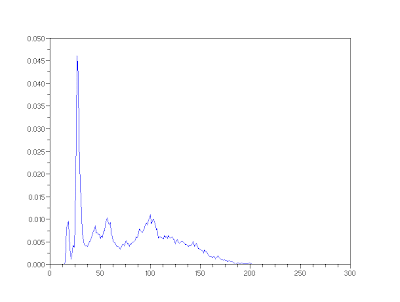In this activity, image enhancement is once again performed by tweaking the cumulative distribution function or the normalized histogram of a grayscale image into functions like the linear, parabolic, and logarithmic functions. Let us examine the PDF and CDF of a sample grayscale image as shown in Figure 1.
Performing histogram backprojection on the image using a linear CDF shown in Figure 2, we get a new image, its PDF and CDF as shown in Figure 3. From the image, PDF and CDF of the new image we can see the presence of higher values making the image brighter and more even.
Performing histogram backprojection on the image using a parabolic CDF shown in Figure 4, we get another new image, its PDF and CDF as shown in Figure 5. Because of the shape of the parabolic CDF, the majority of the pixels have high values thus producing an image with the very bright areas that are not needed as seen in the new x-ray image making it saturated.
Now the human eye has a nonlinear response, specifically a logarithmic response so using a logarithmic CDF shown in Figure 6, we get a new image, its PDF and CDF as shown in Figure 7. Because of the logarithmic trend, the resulting image has high contrast than the linear CDF. The logarithmic response is repeated on another image as shown in Figure 8.






Figure 8. Simulation of human eye response using a logarithmic CDF with original image (left) and new image (right) using logarithmic CDF.
I give myself a grade of 9 for this activity since I was able to do the histogram back projection using different CDFs and was able to produce the PDFs and CDFs of the new images correctly.














what is this histogram back projection method?
ReplyDeleteHistogram backprojection method is done by manipulating the distribution of the gray values in an image into a desired distribution.
ReplyDeletecan u suggest some gud tutorial on backprojection.
Deletejudge.ramaduraird@gmail.com
hi anand perhaps you can try this one, http://docs.opencv.org/doc/tutorials/imgproc/histograms/back_projection/back_projection.html. or you can look up for it in matlab's free classes. are you using matlab/scilab for this?
Delete